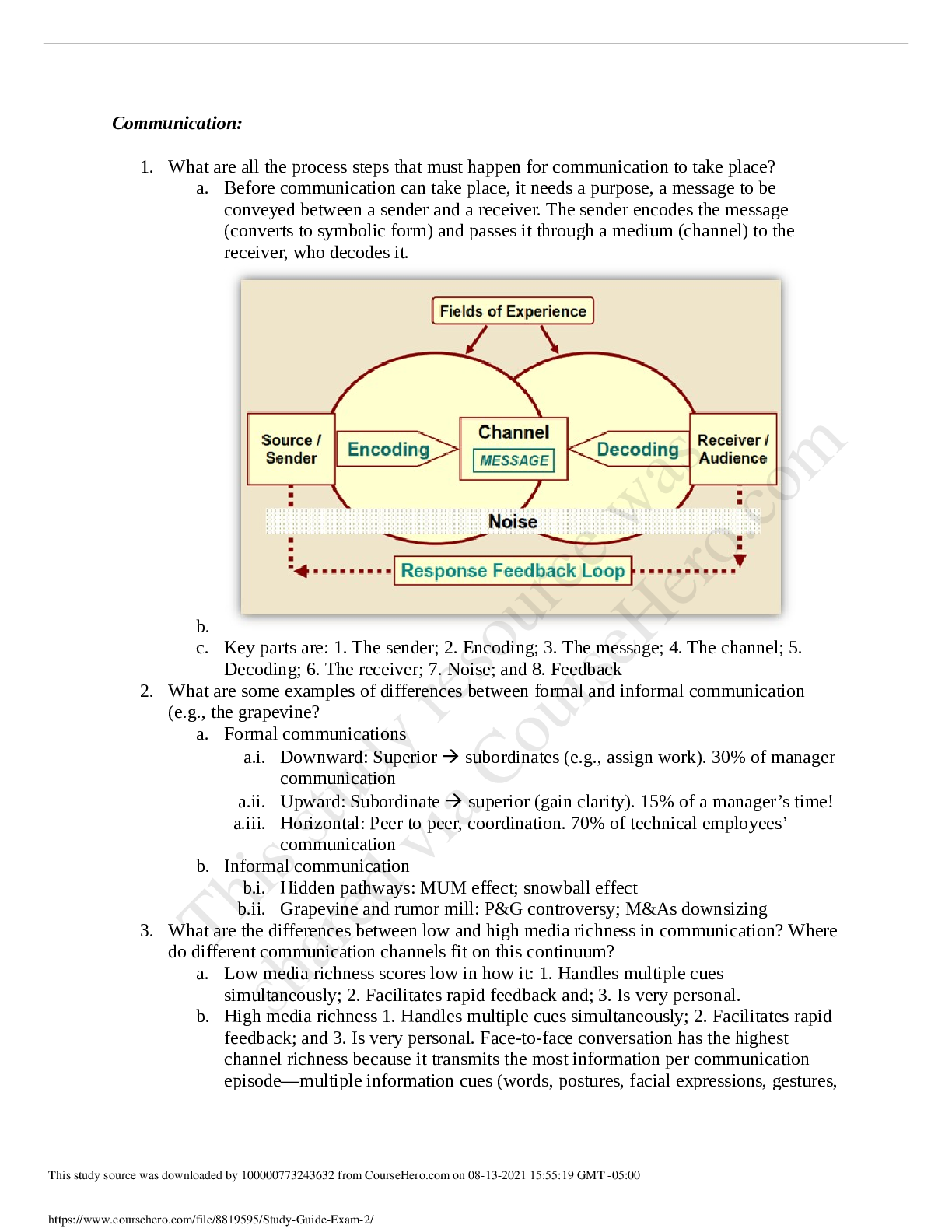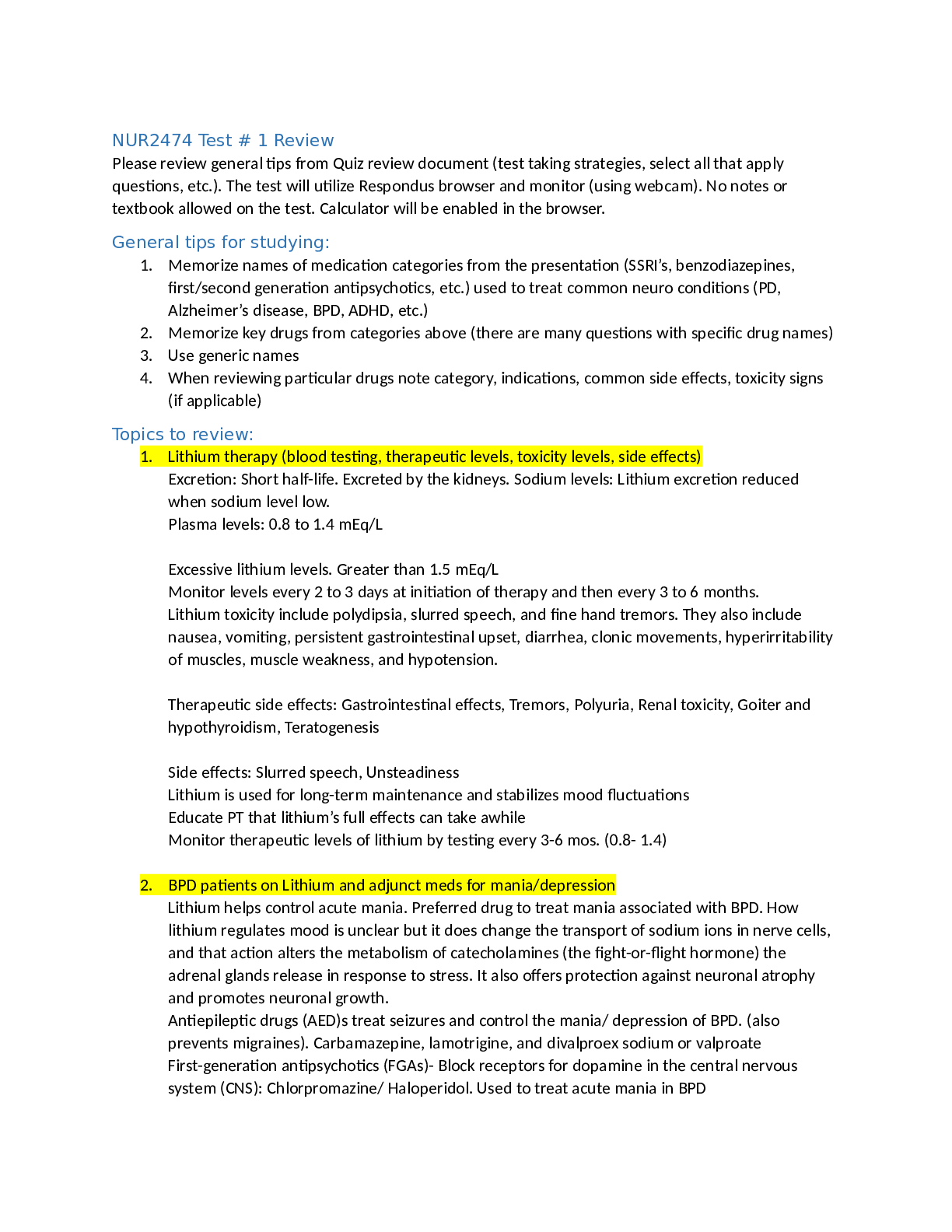Management > EXAM REVIEW > Exam Review>California State University, FullertonMANAGEMENT 340Study Guide Exam 2. 2021 (All)
Exam Review>California State University, FullertonMANAGEMENT 340Study Guide Exam 2. 2021
Document Content and Description Below
Communication: 1. What are all the process steps that must happen for communication to take place? a. Before communication can take place, it needs a purpose, a message to be conveyed between a sen... der and a receiver. The sender encodes the message (converts to symbolic form) and passes it through a medium (channel) to the receiver, who decodes it. b. c. Key parts are: 1. The sender; 2. Encoding; 3. The message; 4. The channel; 5. Decoding; 6. The receiver; 7. Noise; and 8. Feedback 2. What are some examples of differences between formal and informal communication (e.g., the grapevine? a. Formal communications a.i. Downward: Superior subordinates (e.g., assign work). 30% of manager communication a.ii. Upward: Subordinate superior (gain clarity). 15% of a manager’s time! a.iii. Horizontal: Peer to peer, coordination. 70% of technical employees’ communication b. Informal communication b.i. Hidden pathways: MUM effect; snowball effect b.ii. Grapevine and rumor mill: P&G controversy; M&As downsizing 3. What are the differences between low and high media richness in communication? Where do different communication channels fit on this continuum? a. Low media richness scores low in how it: 1. Handles multiple cues simultaneously; 2. Facilitates rapid feedback and; 3. Is very personal. b. High media richness 1. Handles multiple cues simultaneously; 2. Facilitates rapid feedback; and 3. Is very personal. Face-to-face conversation has the highest channel richness because it transmits the most information per communication episode—multiple information cues (words, postures, facial expressions, gestures, This study source was downloaded by 100000773243632 from CourseHero.com on 08-13-2021 15:55:19 GMT -05:00 https://www.coursehero.com/file/8819595/Study-Guide-Exam-2/ This study resource was shared via CourseHero.com intonations), immediate feedback (both verbal and nonverbal), and the personal touch of being present. c. Low media richness is good for routine messages. 4. What are differences between high and low context culture in regards to communication? How did we illustrate these differences in class? a. In high context cultures, people rely more heavily on nonverbal and situational cues, whereas in low context cultures, people rely more on verbal and written words to convey meanings—body language and formal titles come second. 5. What’s a virtual team? What are some of their benefits and pitfalls? How can you minimize the pitfalls? a. Virtual teams use computer technology to unite physically dispersed members and achieve a common goal. b. Benefits: better at sharing unique information c. Pitfalls: less social rapport and direct interaction among members, share less information overall d. Trust must be established among members, team progress is monitored closely; efforts and products of the team are publicized throughout the organization. Start in person, transition to online. 6. What impact does using electronic media (e.g., email) have on our confidence in our ability to communicate? a. Larger gap between anticipated and actual accuracy. Lower actual accuracy, higher anticipated accuracy. 7. What is a structural hole in a social network, and why is it important? What are the benefits of bridging a structural hole? a. 8. What were some conclusions of the research we reviewed in class on multitasking? a. Group dynamics and decision-making: 1. What are norms and roles? Think of examples of each in your own organization a. Role: a set of expected behavior patterns attributed to someone occupying a given position in a social unit a.i. Role perception: our view of how we are supposed to act in a given situation a.ii. Role expectations: the way others believe you should act in a given context. a.iii. Role Conflict: when compliance with one role requirement may make it difficult to comply with another b. Norm: Acceptable standards of behavior within a group that are shared by the group’s members b.i. Performance norm: providing explicit cues about how hard members work, what the level of output should be, how to get the job done, what level of tardiness is appropriate, and the like. Powerful and capable of significantly modifying a performance prediction based solely on ability and level of personal motivation. b.ii. Appearance norms: dress codes, unspoken rules about when to look busy b.iii. Social arrangement norms: with whom to eat lunch, whether to form friendships on and off the job b.iv. Resource allocation norms: assignment of difficult jobs, distribution of resources like pay or equipment 2. What is group cohesion and how is it relevant to groupthink? a. Cohesiveness: the degree to which members are attracted to each other and motivated to stay in the group. a.i. Influenced by: a.i.1. +Severity of initiation into the group a.i.2. +Conditions of external threat a.i.3. +Amount of time that members spend together a.i.4. +History of success a.i.5. –Size of the group (i.e., smaller more cohesive) a.ii. Cautions: a.ii.1. Problem if group and organizational goals conflict a.ii.2. Can blind a group to outside influences b. Relevance to groupthink: Highly cohesive groups may conform so strongly to group pressures on a decision that they fail to think critically and reject the potentially correcting influences of outsiders; group polarization (groupshift)- tendency for members to emerge from group discussion more extreme than they went in. 3. How might different levels of group performance norms and cohesion together impact group performance? a. The relationship between cohesiveness and productivity depends on the group’s performance-related norms. b. If norms for quality, output, and cooperation with outsiders, for instance, are high, a cohesive group will be more productive than will a less cohesive group. c. If cohesiveness is low and performance norms are high, productivity increases, but less than in the high-cohesiveness/high-norms situation. d. When cohesiveness and performance-related norms are both low, productivity tends to fall into the low-to-moderate range. [Show More]
Last updated: 2 years ago
Preview 1 out of 9 pages

Buy this document to get the full access instantly
Instant Download Access after purchase
Buy NowInstant download
We Accept:

Reviews( 0 )
$7.00
Can't find what you want? Try our AI powered Search
Document information
Connected school, study & course
About the document
Uploaded On
Aug 13, 2021
Number of pages
9
Written in
Additional information
This document has been written for:
Uploaded
Aug 13, 2021
Downloads
0
Views
76


.png)










